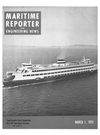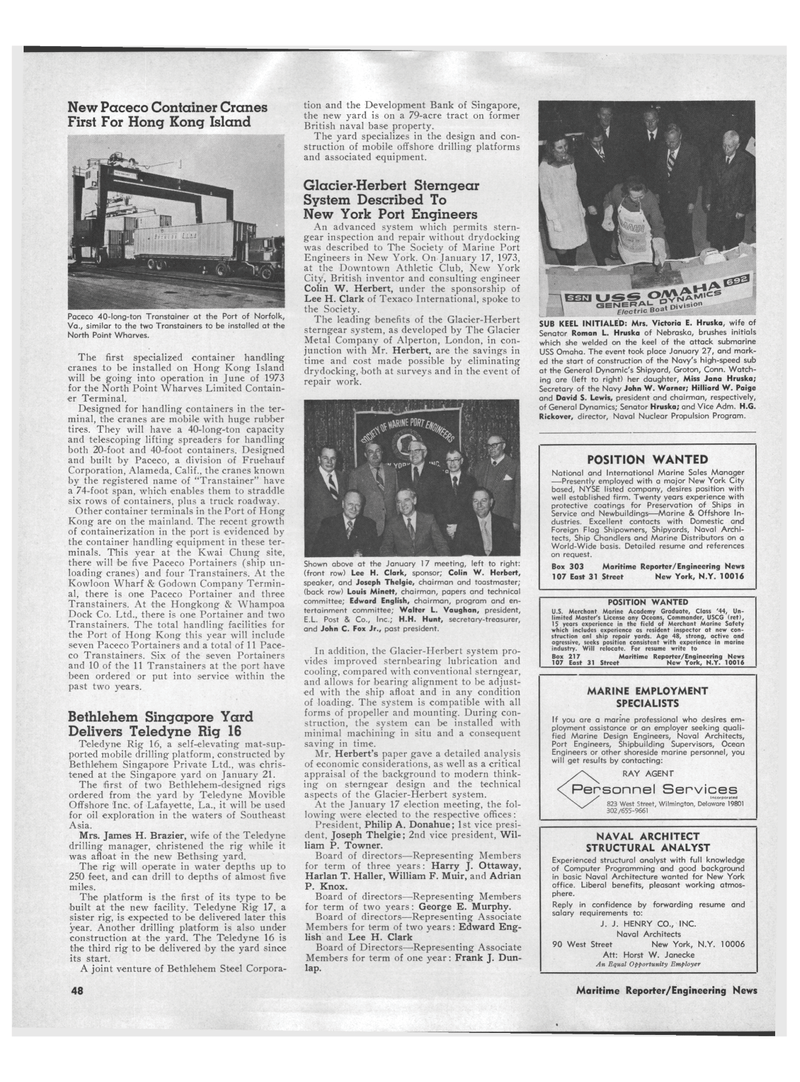
Page 40: of Maritime Reporter Magazine (March 1973)
Read this page in Pdf, Flash or Html5 edition of March 1973 Maritime Reporter Magazine
New Paceco Container Cranes
First For Hong Kong Island
Paceco 40-long-ton Transtainer at the Port of Norfolk,
Va., similar to the two Transtainers to be installed at the
North Point Wharves.
The first specialized container handling cranes to be installed on Hong Kong Island will be going into operation in June of 1973 for the North Point Wharves Limited Contain- er Terminal.
Designed for handling containers in the ter- minal, the cranes are mobile with huge rubber tires. They will have a 40-long-ton capacity and telescoping lifting spreaders for handling both 20-foot and 40-foot containers. Designed and built by Paceco, a division of Fruehauf
Corporation, Alameda, Calif., the cranes known by the registered name of "Transtainer" have a 74-foot span, which enables them to straddle six rows of containers, plus a truck roadway.
Other container terminals in the Port of Hong
Kong are on the mainland. The recent growth of containerization in the port is evidenced by the container handling equipment in these ter- minals. This year at the Kwai Chung site, there will be five Paceco Portainers (ship un- loading cranes) and four Transtainers. At the
Kowloon Wharf & Godown Company Termin- al, there is one Paceco Portainer and three
Transtainers. At the Hongkong & Whampoa
Dock Co. Ltd., there is one Portainer and two
Transtainers. The total handling facilities for the Port of Hong Kong this year will include seven Paceco Portainers and a total of 11 Pace- co Transtainers. Six of the seven Portainers and 10 of the 11 Transtainers at the port have been ordered or put into service within the past two years.
Bethlehem Singapore Yard
Delivers Teledyne Rig 16
Teledyne Rig 16, a self-elevating mat-sup- ported mobile drilling platform, constructed by
Bethlehem Singapore Private Ltd., was chris- tened at the Singapore yard on January 21.
The first of two Bethlehem-designed rigs ordered from the yard by Teledyne Movible
Offshore Inc. of Lafayette, La., it will be used for oil exploration in the waters of Southeast
Asia.
Mrs. James H. Brazier, wife of the Teledyne drilling manager, christened the rig while it was afloat in the new Bethsing yard.
The rig will operate in water depths up to 250 feet, and can drill to depths of almost five miles.
The platform is the first of its type to be built at the new facility. Teledyne Rig 17, a sister rig, is expected to be delivered later this year. Another drilling platform is also under construction at the yard. The Teledyne 16 is the third rig to be delivered by the yard since its start.
A joint venture of Bethlehem Steel Corpora- tion and the Development Bank of Singapore, the new yard is on a 79-acre tract on former
British naval base property.
The yard specializes in the design and con- struction of mobile offshore drilling platforms and associated equipment.
Glacier-Herbert Sterngear
System Described To
New York Port Engineers
An advanced system which permits stern- gear inspection and repair without drydocking was described to The Society of Marine Port
Engineers in New York. On January 17, 1973, at the Downtown Athletic Club, New York
City, British inventor and consulting engineer
Colin W. Herbert, under the sponsorship of
Lee H. Clark of Texaco International, spoke to the Society.
The leading benefits of the Glacier-Herbert sterngear system, as developed by The Glacier
Metal Company of Alperton, London, in con- junction with Mr. Herbert, are the savings in time and cost made possible by eliminating drydocking, both at surveys and in the event of repair work.
Shown above at the January 17 meeting, left to right: (front row) Lee H. Clark, sponsor; Colin W. Herbert, speaker, and Joseph Thelgie, chairman and toastmaster; (back row) Louis Minett, chairman, papers and technical committee; Edward English, chairman, program and en- tertainment committee; Walter L. Vaughan, president,
E.L. Post & Co., Inc.; H.H. Hunt, secretary-treasurer, and John C. Fox Jr., past president.
In addition, the Glacier-Herbert system pro- vides improved sternbearing lubrication and cooling, compared with conventional sterngear, and allows for bearing alignment to be adjust- ed with the ship afloat and in any condition of loading. The system is compatible with all forms of propeller and mounting. During con- struction, the system can be installed with minimal machining in situ and a consequent saving in time.
Mr. Herbert's paper gave a detailed analysis of economic considerations, as well as a critical appraisal of the background to modern think- ing on sterngear design and the technical aspects of the Glacier-Herbert system.
At the January 17 election meeting, the fol- lowing were elected to the respective offices:
President, Philip A. Donahue; 1st vice presi- dent. Joseph Thelgie; 2nd vice president, Wil- liam P. Towner.
Board of directors—Representing Members for term of three years: Harry J. Ottaway,
Harlan T. Haller, William F. Muir, and Adrian
P. Knox.
Board of directors—Representing Members for term of two years: George E. Murphy.
Board of directors—Representing Associate
Members for term of two years: Edward Eng- lish and Lee H. Clark
Board of Directors—Representing Associate
Members for term of one year: Frank J. Dun- lap.
SUB KEEL INITIALED: Mrs. Victoria E. Hruska, wife of
Senator Roman L. Hruska of Nebraska, brushes initials which she welded on the keel of the attack submarine
USS Omaha. The event took place January 27, and mark- ed the start of construction of the Navy's high-speed sub at the General Dynamic's Shipyard, Groton, Conn. Watch- ing are (left to right) her daughter, Miss Jana Hruska;
Secretary of the Navy John W. Warner; Hilliard W. Paige and David S. Lewis, president and chairman, respectively, of General Dynamics; Senator Hruska; and Vice Adm. H.G.
Rickover, director. Naval Nuclear Propulsion Program.
POSITION WANTED
National and International Marine Sales Manager —Presently employed with a major New York City based, NYSE listed company, desires position with well established firm. Twenty years experience with protective coatings for Preservation of Ships in
Service and Newbuildings—Marine & Offshore In- dustries. Excellent contacts with Domestic and
Foreign Flag Shipowners, Shipyards, Naval Archi- tects, Ship Chandlers and Marine Distributors on a
World-Wide basis. Detailed resume and references on request.
Box 303 Maritime Reporter/Engineering News 107 East 31 Street New York, N.Y. 10016
POSITION WANTED
U.S. Merchant Marine Academy Graduate, Class '44, Un- limited Master's License any Oceans, Commander, USCG (ret), 15 years experience in the field of Merchant Marine Safety which includes experience as resident inspector at new con- struction anl ship repair yards. Age 48, strong, active and agressive, seeks position consistent with experience in marine industry. Will relocate. For resume write to
Box 217 Maritime Reporter/Engineering News 107 East 31 Street New York, N.Y. 10016
MARINE EMPLOYMENT
SPECIALISTS
If you are a marine professional who desires em- ployment assistance or an employer seeking quali- fied Marine Design Engineers, Naval Architects,
Port Engineers, Shipbuilding Supervisors, Ocean
Engineers or other shoreside marine personnel, you will get results by contacting:
RAY AGENT
NAVAL ARCHITECT
STRUCTURAL ANALYST
Experienced structural analyst with full knowledge
of Computer Programming and good background
in basic Naval Architecture wanted for New York
office. Liberal benefits, pleasant working atmos-
phere.
Reply in confidence by forwarding resume and
salary requirements to:
J. J. HENRY CO., INC.
Naval Architects
90 West Street New York, N.Y. 10006
Att: Horst W. Janecke
An Equal Opportunity Employer
48 Maritime Reporter/Engineering News

 39
39

 41
41
